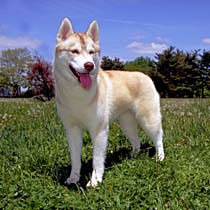|
The Canine Chronicles Directory
Siberian Husky

The Siberian Husky is a strong, working dog. This compact dog comes in all colors
ranging from white to brown, red to black, with all colors in between. Some markings
are similar to that of a pinto horse. There are striking markings on the breed's
head and body. The mask of the face and the underbody are usually white, with the
remaining coat any color. Their ears are erect and sit high on the head. Their almond-shaped
eyes can be blue, amber, brown or any combination including half blue and half brown
(parti-eyed). This breed can also be bi-eyed, having one blue eye and one brown
eye. The neck is medium in length and is carried erect when the dog is standing.
The neck is extended and carried forward when the dog is trotting. The feet are
very large and are considered "snow-shoe feet" as they have hair between the toes
for help gripping the ice better. The tail, set just below the topline, is long,
bushy, sickle-shaped and is carried over the back. The double-coated Husky can withstand
temperatures as low as -58° to -76° F.
|
|
Temperament
|
The Husky is playful, cheerful, clever, sociable and docile. They are very fond
of their family. They are great with children. They love everyone and bark little,
which is why they do not make good watchdogs. This breed is very intelligent but
can be a bit willful. They will obey commands if there is a point to it. They need
a patient and consistent owner who understand the Arctic dog's character. They like
to howl and may be difficult to housebreak. They love living in packs and do not
like to be left alone. Remember, a lonely Husky is a destructive Husky. They do
well with other pets if they are raised with them. They do not require a lot of
food making them thrifty eaters. They like to roam.
|
|
Height, Weight
|
Male Height: 21-24" ; Weight: 45-60 lbs.
Female Height: 20-22" ; Weight: 35-50 lbs.
|
|
Health Problems
|
Minor concerns in this breed are hip dysplasia, PRA, corneal dystrophy and zinc
responsive dermatitis.
|
|
Living Conditions
|
Siberians will do okay in an apartment if it is well trained and sufficiently exercised.
They do best with a fenced-in yard. This breed prefers cooler climates and living
in packs.
|
|
Exercise
|
This breed needs lots of exercise but not in warmer weather. They require a high
fence and wiring under the fence line to prevent them from digging and running off.
They make excellent jogging companions as long as the weather is not too hot.
|
|
Life Expectancy
|
About 12-15 years
|
|
Grooming
|
This breed needs to be groomed twice a year with a metal comb when they are shedding.
This breed is a seasonal heavy shedder.
|
|
Origin
|
Native to Siberia, Siberian Chukchis were brought into Alaska in the early 1900s
and quickly gained a reputation for sledding. The Chukchi dog in pure form, or crossed
with other native sledding breeds, became universal, especially in chores where
speed with endurance was of upmost importance, such as mail delivery and long-distance
sled dog racing. He was, at that time, still called Chukchi or "husky", a generic
term for a sled-pulling dog. As the breed gained a foothold with American dog fanciers,
the name Chukchi was replaced by the more general term Siberian Husky, and that
became his official name. Thanks to the Chukchi tribe selection for good temperament,
he is people-oriented and a popular companion dog. They are recognized by the AKC
and the UKC.
|
|
Group
|
AKC Working, UKC Northern Breed
|